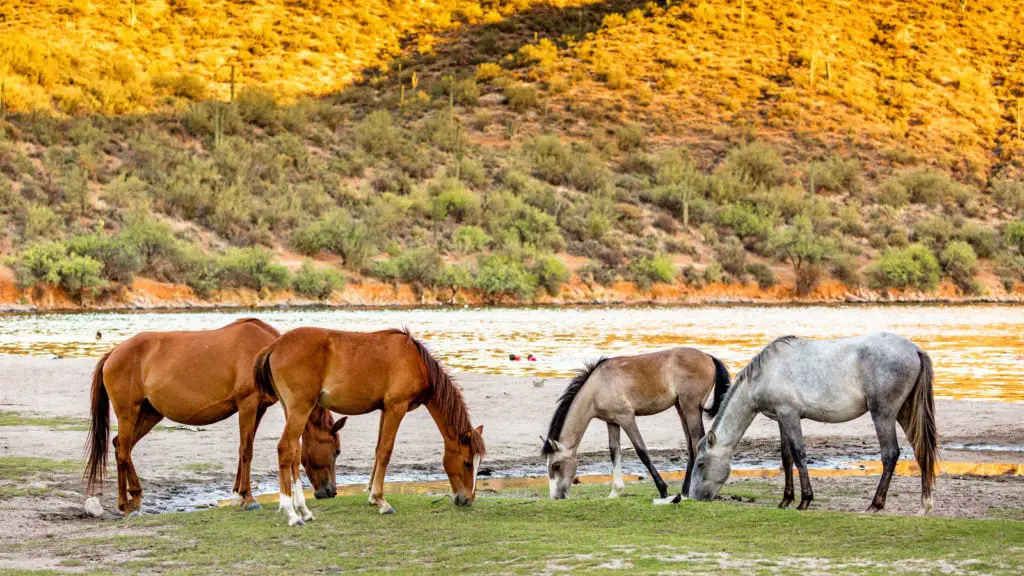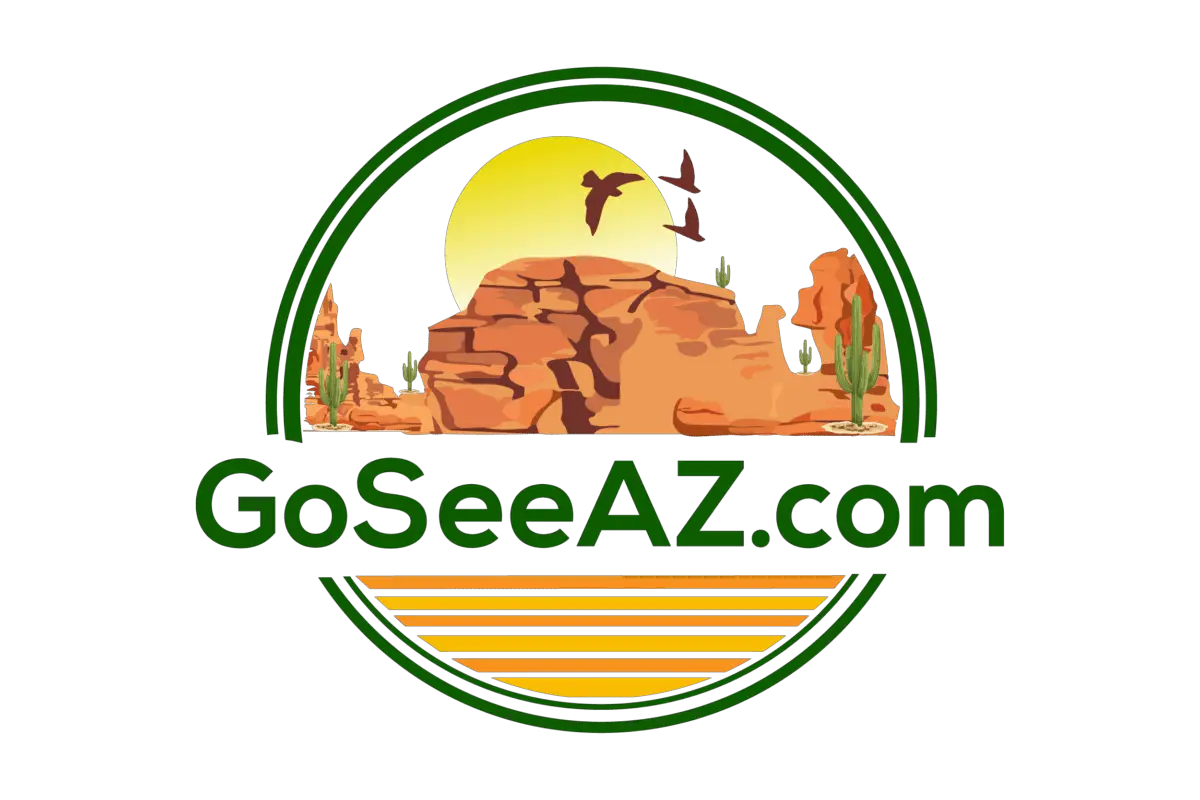Are there wild horses in Arizona? Arizona is known for its beautiful and diverse natural wonders. From the Grand Canyon to Saguaro National Park, every corner of Arizona holds nature, wildlife, and plant life that will take your breath away. If you’re reading this article, you’re probably wondering if a specific animal exists in Arizona – wild horses.
Are There Wild Horses in Arizona?
The short answer to this question is yes, there are wild horses in Arizona. They seem to be scattered all over a lot of the state in small bands. Here’s the general areas we’ve had the pleasure of seeing them being: Northern Arizona on the Reservations, in the Payson/Heber area, just outside of Show Low, Florence township, along the 10 just South of Tempe, rural Maricopa, and along the Salt River in Usery Park. A good number of Arizona’s wild horses reside in Tonto National Forest along the Salt River, a river that runs through Arizona. But, there’s a caveat – they are a small number of them and they can be hard to sight.
We’ll tell you all about the Salt River wild horses in this article, including a short history of the horses, where to find them now, and the best way to see them when in Arizona. Keep reading to uncover all you need to know about the Salt River wild horses.

Wild horses running in a desert 
Wild horses running 
A herd of brown horses walking in the forest.
Arizona’s Wild Horses: A History
With all of its diverse wildlife, it’s no surprise that there are still wild horses in Arizona.
The Salt River wild horses have lived in the Tonto National Forest for hundreds of years. The first official record of these horses was in 1902, when the Tonto National Forest was founded. At that time, Arizona’s historical records acknowledged the existence of these wild horses. The records mentioned both their existence then and the hypothesis that they were inhabiting that area well before 1902.
There is another mention of the Salt River wild horses in an Arizona State Archive from 1890. Then, the Arizona Champion Newspaper mentioned the horses, calling them native stock/native animals. This mention is likely the first official mention of the Salt River wild horses. At the time, they lived all over the land, not just by the Salt River.
Even before that, it is presumed by historians that Father Eusebio Keno, a missionary important in Arizona’s history, left hundreds of wild horses at his missions, and the stockyards developed through the missions in 1687. He partook his missions and expeditions over horseback, so it can be assumed that he had access to horses – the Salt River wild horses. It is not surprising that he utilized the horses, as there were a huge number of them at the time. So, the Arizonian wild horses can safely be tracked back to the 1600s, though it is probably that they were present in what is now known as the Tonto National Forest before then.
Why are there only a few hundred left?
As we mentioned, there aren’t as many wild horses as there used to be. In the early 1800s, there were large herds of both horses and bison roaming around southern Arizona. Settlers and explorers found this mass number of horses/bison to be an obstacle in their day-to-day life, and so began the mass extermination of these animals. At that time, wild horses were considered quite useless. Settlers and explorers preferred to raise and eat cow, so they started to mass exterminate the wild horses through shootings and poison.

While this is illegal now, at the time it was completely legal. In fact, the ranchers and Forest Service were the organizing body of the roundups and killings. The mass extermination started in 1850 and continued for years, through the early 1900s. In 1908, the Forest Service put out an order to exterminate every wild horse found on site. Then, there were estimated to be around 500,000 wild horses present in the area. If you think about how long the extermination lasted, you can imagine the number of horses present in the 1700s and early 1800s.
It may seem cruel that there was a mass extermination of horses, but if you put it into context, it is easier to understand. Now, wild horses are valued for their beauty and wildlife diversity. At the time, wild animals were viewed more practically. Since there were plenty of horses to ride, the Arizonians didn’t need the amount of horses that existed. Horses are large, and wild horses can go rogue. Since the settlers didn’t have a need for them and the horses were preventing them from settling peacefully, they chose to exterminate them.
How did the Salt River wild horses survive?
While a majority of the wild horses were exterminated, some did survive – the Salt River wild horses. It is believed that this sect of wild horses hid along the Salt River banks in the thick vegetation. We’ve recently been through an area of the Salt River to try and find them and they have perfected their hiding in this terrain Very WELL! They hid out there for years and years, surviving off the food and water from the Salt River. Something that I recently learned was that the river provides eel grass in the summer months that gives the horses extra nutrients during the extra hot months which is at least 1 of the reasons why they must be thriving in the area. Now, there are estimated to be less than 500 of the Salt River wild horses in Arizona.

Salt River Wild Horses Today
As you may know, Arizona is a state symbolic of the Old West. Think: cowboys, gun fights, and wild horses. All of this was a part of Arizona’s past, and luckily, wild horses are still part of Arizona. The Salt River wild horses, in part, help us remember Arizona’s past and its connection to the wild West.
While the number is certainly lower than hundreds of years ago, there are still around 500 of the Salt River wild horses roaming around Arizona. Up until recently, these horses are allowed to roam and run fairly freely, scavenging for food independently, but are considered feral.
In regards to an animal, feral means that the animal is wild, but is existing in a wild state after being held captive or domesticated. The Salt River wild horses today are fully wild, but they are descendants of horses that were once held captive. During the Spanish conquests of the New World, these horses were brought to North America. Then, the horses were domesticated to a certain extent and used for practical purposes in the Spanish conquests.
Of course, the Spanish horses are long gone, but the Salt River horses are removed descendants of these horses. The ferality of the horses is quite common, as most wild horses in the United States are considered both feral and wild.
Salt River Horse Advocacy
After the mass extermination of the wild horses, local animal support advocates started to fight for the wild horses. This spurred the creation of the Salt River Wild Horse Management Group, the non-profit body tasked with advocating for, protecting, and managing the wild horses. Now, the Salt River Wild Horse Management Group and the Arizona Department of Agriculture have reached an agreement on how to manage and control the population of the horses. The Salt River Wild Horse Management Group is fully responsible for managing the horses and their population. To do so, they give the horses a humane birth control vaccine. Because of this group, the horses are able to run freely without fear of extermination.

How to See the Salt River Wild Horses
It can often be difficult to observe wild animals in their natural habitats. There can be safety concerns, lack of accessibility, and other obstacles. With the Salt River wild horses, however, you’re in luck. There are a variety of sites where you can see the Salt River wild horses and we added a couple extra spots just because.
Here are some of the best:
- Phon D. Sutton Recreation Site
- Granite Reef
- Coon Bluff
- Butcher Jones Recreation Site
- Blue Point
- Saguaro Lake
- Pebble Beach Recreation Area
- Salt River (accessible by Kayak through Saguaro Lake Ranch)
- Usery Park
- Along SR 374 near Maricopa
Some of these places may need a Tonto National Forest pass or Maricopa County Parks and Recreation Department pass, so make sure to do your research before going.
Our key recommendation is to kayak along the Salt River for the best experience viewing the horses. We saw a few different bands this way as they were eating the eel grass and getting some water. No matter where you go, try to go early in the morning before it is too hot. If you do that, you’ll have a higher likelihood of seeing the horses and other wildlife. Kayaking along the river is a beautiful journey, where you will hopefully see the Salt River wild horses, blue herons, bald eagles, and river otters for yourself- if you’re lucky. The river is the perfect places to observe the horses drinking from the river and interacting with each other.
Also, when you’re out driving in these areas listed above be sure to keep your eyes peeled and keep looking out your window as they can be right next to your vehicle under the shade of a tree or among bushes just quietly eating away. That happened to us just a couple of weeks ago when we were giving our friends a tour of the Usery Park area. Take your time on these roads so you don’t miss them!
As always, you aren’t guaranteed to see the horses. If you are taking a trip just to see the horses, it is best to allot a few days in case you can’t spot them at first. The horses are wild, so they are free to roam and migrate as they please, meaning that their location is uncontrollable. If you are able, plan to spend a few days in the area and be flexible with timing and viewing location. Make sure to never get too close to the horses, as you do not want to disturb them and they can be dangerous. If you’re still unsure of how to see the horses, consider hiring a local guide or talk to other people, especially those with a camera in their hands as they may also be trying to get a glimpse of them as well and as they know might know the spots the horses frequent.
The Salt River wild horses are a special part of Arizona. If you choose to visit, we’re hoping you get lucky enough to see, observe, and take in all that these beautiful animals are.



